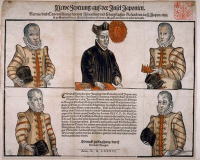

Footprints of Jurian Nakaura@No.6
Thus, Jurian Nakaura left Nagasaki port with Mansho Ito, Migeru Chijiwa,
and Maruchino
Hara headed by the leader of the embassy, Alessandro Valignano and the
guide, Diogo
Mezquita while Jurian's mother and his two sisters saw him off. It was
February 20th,
1582. He was only 14. In the age with no guarantee of certainly reaching
Europe, they
sailed for Europe at the risk of their lives while many ships were wrecked
on the way.
Moreover, they got stuck for several months because they needed wind for
sailing.
Nevertheless, it was a great joy for Jurian to execute his mission given by Jesus he loved
and to follow Valignano whom he trusted in and respected. He traveled on this long voyage
while dreaming about far off distant Europe he had not yet seen, praying everyday and
singing praises to the Lord with brothers of the like-minded, who had learned
with him
guided by the Lord. This period became an important opportunity for him
to learn faith and
patience.
In this embassy, along with these four boys, there were also two Christian
boys who were
going to be trained as operatives for the printing press which was going to be brought back
to Japan, and 19-year-old young Christian as a teacher for the four boys
including Jurian.
They continued a trip from Macau to Malacca, furthermore to Goa in India.
Sad to say,
Valignano who were well-liked by Jurian and the other boys could not go
to Rome with
them because he was ordained the leader of Indian diocese. Nuno Rodriguez
was assigned
as his successor. It was Father Mezquita who had been with the boys, encouraged
them, and
guided them throughout the course since they left Nagasaki until they returned
to Japan.
Furthermore, they passed through the Cape of Good Hope at the southern
tip of Africa,
and finally sailed into the port of Lisbon (Spanish Portugal of that time)
in August 10th,
1584 after two and a half years of sailing.
It was eight years and five months later that they returned to Japan again.
At this time,
they had no way of finding that the conditions surrounding Japan had been
drastically
changed during that time.
(The Kyoto Glory Church Translation Committee is
responsible for the wording of this article.)
(Father Mezquita (center)
and the first Japanese
Embassy to Europe)